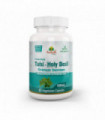Terminalia chebula is a tree that grows throughout the Middle East, India, China and Thailand. This plant is known as "Haritaki" in Ayurveda, where the small, green fruit of the Terminalia chebula tree is used. It is a dry, warm, slightly sweet, bitter and astringent herb. Haritaki is held in high esteem in Ayurveda and often referred to as the "king of medicines".
Along with Giloy and Garlic, Haritaki is one of the 3 nectars of Ayurveda. Haritaki contains phytochemicals such as terpenes, polyphenols, anthocyanins and flavonoids, and is rich in tannin. It contains 18 amino acids, 12 fatty acids and small amounts of fructose, polyphenols and phosphoric acids.
Terminalia chebula is a tree that grows throughout the Middle East, India, China and Thailand. This plant is known as "Haritaki" in Ayurveda, where the small, green fruit of the Terminalia chebula tree is used. It is a dry, warm, slightly sweet, bitter and astringent herb. Haritaki is held in high esteem in Ayurveda and often referred to as the "king of medicines".
Along with Giloy and Garlic, Haritaki is one of the 3 nectars of Ayurveda. Haritaki contains phytochemicals such as terpenes, polyphenols, anthocyanins and flavonoids, and is rich in tannin. It contains 18 amino acids, 12 fatty acids and small amounts of fructose, polyphenols and phosphoric acids.






















